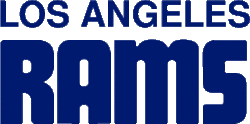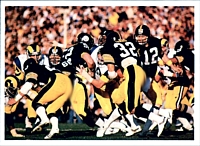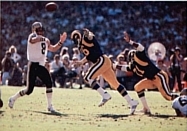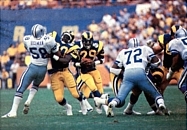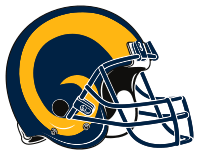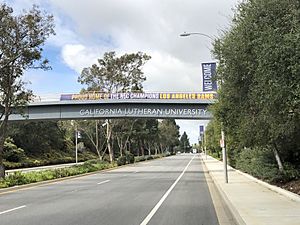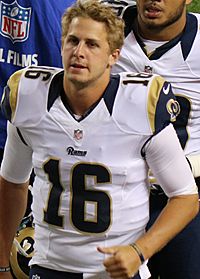History of the Los Angeles Rams facts for kids
The Los Angeles Rams are a professional American football team that plays in the National Football League (NFL). The Rams team started in 1936 as the Cleveland Rams in a league called the American Football League. The next year, they joined the NFL. In 1946, the team moved to Los Angeles.
The Rams stayed in the Los Angeles area until 1994. Then, they moved to St. Louis and were known as the St. Louis Rams from 1995 to 2015. In 2016, the Rams team came back to Los Angeles. This article tells the story of the team during its time in Los Angeles. They played at the Los Angeles Memorial Coliseum from 1946 to 1979, then at Anaheim Stadium (now Angel Stadium of Anaheim) in Anaheim from 1980 to 1994. When they returned in 2016, they played at the Los Angeles Memorial Coliseum again until 2019, before moving to SoFi Stadium in Inglewood in 2020. They now share SoFi Stadium with the Los Angeles Chargers.
Contents
- A New Start in Los Angeles
- The St. Louis Years (1995–2015)
- Back in Los Angeles (2016–Present)
- List of Seasons
- Pro Football Hall of Famers
- Radio and Television
- In Popular Culture
A New Start in Los Angeles
The Rams Arrive in L.A. (1946–1948)
On January 12, 1946, the owner of the Cleveland Rams, Dan Reeves, wanted to move his team to Los Angeles. Other NFL owners didn't want him to, but Reeves insisted. He said he would leave professional football if he couldn't move the team. So, the NFL allowed the Rams to move to Los Angeles. This made the NFL the first professional sports league to have teams on both the East and West Coasts.
Before 1946, there were no Black players in professional American football. When the Rams wanted to use the Los Angeles Memorial Coliseum, they were told they had to sign at least one African-American player. The Rams agreed. On March 21, 1946, they signed Kenny Washington. This was a big moment for the NFL. On May 7, 1946, they added another Black player, Woody Strode.
The Rams were the first NFL team to play in Los Angeles. They played their first pre-season game against the Washington Redskins in front of 95,000 fans. The team finished their first season in L.A. with a 6 wins, 4 losses, and 1 tie record. In 1948, player Fred Gehrke painted horns on the Rams' helmets. This was the first time a professional football team had a modern logo on its helmet.
High-Flying Offense (1949–1956)
The Rams had a great period from 1949 to 1955. They played in the NFL Championship Game four times and won once in 1951. During this time, they had one of the best offenses in the NFL. Key players were wide receiver Elroy Hirsch, and quarterbacks Bob Waterfield and Norm Van Brocklin. Elroy Hirsch was known for making big plays. In their 1951 championship season, he had an amazing 1,495 receiving yards and 17 touchdowns. Because their offense was so exciting, the Los Angeles Rams became the first professional football team to have all their games shown on TV in 1950.
Growing Popularity (1957–1964)
In the late 1950s and early 1960s, other major sports teams moved to Los Angeles, like the Dodgers (baseball) and Lakers (basketball). Even with more teams, the Rams remained very popular. They often filled the huge Los Angeles Memorial Coliseum. In 1957, the Rams set an NFL attendance record with 102,368 fans at one game. Even though the team didn't win many games during this time, fans still loved to watch them play.
The Fearsome Foursome (1965–1969)
The 1960s were famous for the Rams' amazing defensive line, known as the "Fearsome Foursome." This group included Rosey Grier, Merlin Olsen, Deacon Jones, and Lamar Lundy. They helped the team become successful again. In 1967, under coach George Allen, the Rams reached the conference championship game. That year, the team became the first NFL team to have over one million fans attend their games in a single season.
Coach George Allen led the Rams from 1966 to 1970. He brought in new ideas, like hiring Dick Vermeil as one of the first special teams coaches. Allen had five winning seasons and won two division titles, but he never won a playoff game with the Rams.
Changes and NFC West Champions (1970–1979)
Quarterback Roman Gabriel played for the Rams for eleven seasons. In 1969, he was named the NFL's Most Valuable Player. In 1972, the team got a new owner, Carroll Rosenbloom. The Rams continued to be strong, winning seven straight NFC West championships from 1973 to 1979.
Chuck Knox's Coaching and Tough Defense
Chuck Knox coached the Rams during this time. His teams were known for their strong defense, which helped them reach the playoffs every year. A key player was Jack Youngblood, a defensive end known for his toughness. He even played on a broken leg during a playoff run. Many Rams players from this era became actors after their football careers, like Fred Dryer and Merlin Olsen.
In 1979, the Rams had a 9–7 record, which wasn't their best, but they made it to their first Super Bowl. Led by quarterback Vince Ferragamo, they surprised many by beating the Dallas Cowboys and then shutting out the Tampa Bay Buccaneers to win the NFC title.
First Super Bowl Appearance (1979)
The Rams played against the Pittsburgh Steelers in Super Bowl XIV. The game was played in Pasadena, California, which was almost a home game for the Rams. Even though the Steelers were favored to win, the Rams played very well, leading 13–10 at halftime and 19–17 at the end of the third quarter. But in the fourth quarter, the Steelers scored two touchdowns and won 31–19.
Moving to Anaheim (1980–1994)

In 1979, owner Carroll Rosenbloom passed away, and his wife, Georgia Frontiere, took over the team. In 1980, the Rams moved from the Los Angeles Memorial Coliseum to Anaheim Stadium in Orange County. One reason for the move was that the Coliseum was so big (92,604 seats) that it was hard to sell enough tickets to avoid TV blackouts. Anaheim Stadium was smaller, making it easier to sell out games and have them televised.
The stadium was originally built for baseball, so it was changed to fit football. With their new home, the Rams had no trouble selling out games.
In 1980, the team had a good 11–5 record but lost in the playoffs. The early 1980s were tough for the Rams, with some losing seasons.
Sharing the City with the Raiders
In 1982, the Oakland Raiders also moved to Los Angeles and played at the Coliseum. This split the Rams' fan base. The Raiders won the Super Bowl in 1983, while the Rams were rebuilding. Other Los Angeles teams like the Lakers (basketball) and Dodgers (baseball) were also winning championships. Because of this, the Rams became less popular in the 1980s, even though they were still a playoff team.
The Dickerson Era (1983–1991)
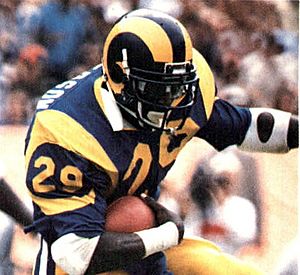
In 1983, John Robinson became the new coach. He helped the team improve, and they made the playoffs in 1983 and 1984. The most famous player during this time was running back Eric Dickerson. He was drafted in 1983 and had an amazing year in 1984, rushing for 2,105 yards. This set a new NFL record that still stands today! Dickerson was traded in 1987 after a contract disagreement.
Even after Dickerson left, the Rams continued to be strong thanks to offensive coordinator Ernie Zampese. He brought in new plays that made the Rams' offense one of the best in the league. Quarterback Jim Everett and wide receiver Henry Ellard were key players.
The Rams had a good season in 1989, winning 11 games and making it to the NFC Championship Game. However, they lost to the San Francisco 49ers. After 1989, the Rams had several losing seasons and didn't make the playoffs again during their first time in Los Angeles.
The End of an Era (1992–1994)
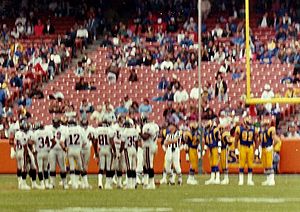
Coach John Robinson was fired in 1991, and Chuck Knox returned as head coach. But his run-focused offense didn't help the team win. The Rams finished last in their division for three straight years. As the team kept losing, fewer fans came to games, and more games were blacked out on TV. One bright spot was running back Jerome Bettis, who had two great seasons.
The Rams started to blame their stadium situation for their problems. They wanted a new or improved stadium, but Orange County was in a recession, and the team couldn't get funding. This made the team's future in Southern California uncertain.
The Rams Leave Los Angeles
Owner Georgia Frontiere decided to move the team. She first tried to move them to Baltimore, but other NFL owners said no. Then she tried to move them to St. Louis. This was also initially rejected by the owners, who felt the team's problems were due to poor management, not the stadium. However, Frontiere threatened to sue the league, and the owners eventually agreed to let the Rams move to St. Louis.
As part of the deal, St. Louis agreed to build a new stadium, the Trans World Dome. This move left many fans in Los Angeles feeling upset. For the first time in 50 years, Los Angeles had no NFL team.
The St. Louis Years (1995–2015)
While in St. Louis, the Rams played their first few games at Busch Memorial Stadium before their new stadium, the Dome at America's Center, was finished. The team had a very successful period from 1999 to 2004, with an offense called "The Greatest Show on Turf." They won Super Bowl XXXIV in 1999 and reached another Super Bowl in 2001, but lost to the New England Patriots. Other than these years, the St. Louis Rams often had losing seasons.
Trying to Bring the NFL Back to L.A.
After the Rams and Raiders left, Los Angeles tried for many years to get another NFL team. Several teams were rumored to move there, but they often used Los Angeles as a way to get their own cities to build new stadiums. For example, the Seattle Seahawks owner tried to move his team to Los Angeles in 1996, but it didn't happen. In 1999, the NFL even approved a new team for Los Angeles, but a stadium deal couldn't be reached, and the team went to Houston instead (the Houston Texans).
A New Stadium Plan
On January 31, 2014, news came out that Rams owner Stan Kroenke bought a large piece of land in Inglewood, California. He later announced plans to build a new NFL stadium there. This made many people think the Rams would move back to Los Angeles. The city of Inglewood approved the stadium plan in February 2015, and construction began in December 2015.
Meanwhile, the Rams and St. Louis officials had problems with their stadium lease. The Edward Jones Dome in St. Louis was not considered one of the best stadiums in the league, as required by their lease. St. Louis was unwilling to pay for the expensive upgrades the Rams wanted.
The Rams Return to Los Angeles (2016)

On January 4, 2016, the St. Louis Rams officially asked to move to Los Angeles for the 2016 NFL season. The Oakland Raiders and San Diego Chargers also wanted to move to L.A. After meetings and votes by NFL owners, it was decided that the Rams would move back to Los Angeles. The Chargers were given the option to join them, which they did in January 2017.
Back in Los Angeles (2016–Present)
When the Rams returned to Los Angeles in 2016, they played their home games at the Los Angeles Memorial Coliseum again, which was their home for many years before. This was a temporary home until SoFi Stadium was finished in 2020.
The Rams' return to Los Angeles also helped the NFL grow its presence around the world. In 2016, the Rams played a game in London as part of the NFL's International Series.
The Jared Goff Era Begins (2016)
On April 13, 2016, the Rams made a big trade to get the first pick in the NFL Draft. On April 28, 2016, they used that pick to draft quarterback Jared Goff from California.
The Rams played their first game back in Los Angeles since 1994 (a 22-year break) on August 13, 2016, a pre-season game against the Dallas Cowboys. They won 28–24 in front of a record crowd of 89,140 fans. Their first regular season home game was on September 18, 2016, where they beat the Seattle Seahawks 9–3.
However, the team struggled that season. On December 12, 2016, head coach Jeff Fisher was fired after the team started with a 4-9 record.
Sean McVay's Arrival and Success (2017–2018)
On January 12, 2017, the Rams hired Sean McVay as their new head coach. At 30 years old, McVay became the youngest head coach in NFL history. Under McVay, quarterback Jared Goff improved a lot, and running back Todd Gurley became a dominant player again.
In 2017, the Rams had their first winning season since 2003. On December 24, 2017, they won their division, the NFC West, for the first time since 2003. They made the playoffs but lost to the Atlanta Falcons.
Super Bowl Run (2018)
The 2018 season was amazing for the Rams. They added talented players like Marcus Peters, Ndamukong Suh, Aqib Talib, and Brandin Cooks. They also signed star players like Todd Gurley and Aaron Donald to long-term deals.
The Rams started the season with 8 wins and no losses, their best start since 1969. They finished the regular season with an impressive 13 wins and 3 losses, which was tied for the best record in the league. This was the most wins for any NFL team in Los Angeles history.
In the playoffs, the Rams beat the Dallas Cowboys and then had a thrilling overtime win against the New Orleans Saints in the NFC Championship Game. This sent them to the Super Bowl for the first time since 2001 (when they were in St. Louis) and their first time representing Los Angeles since 1979. In Super Bowl LIII, they faced the New England Patriots. The Rams' offense struggled, and they lost 13–3.
New Stadium and Super Bowl Win (2019–2021)
The 2019 season was tougher for the Rams, and they missed the playoffs. This was also their last year playing at the Los Angeles Memorial Coliseum.
SoFi Stadium Debut (2020)
In 2020, the Rams moved into the brand new SoFi Stadium. However, due to the COVID-19 pandemic, they had to play without fans in the stands. Despite this, the Rams finished the season with 10 wins and 6 losses, making it back to the playoffs. They beat the Seattle Seahawks in the first round but then lost to the Green Bay Packers.
Super Bowl Champions (2021)
On March 18, 2021, the Rams made a big trade, sending Jared Goff to the Detroit Lions for their longtime quarterback Matthew Stafford. The Rams started the season strong, winning seven of their first eight games. They also added star players like wide receiver Odell Beckham Jr. and linebacker Von Miller. The Rams finished the regular season with 12 wins and 5 losses, winning their division again.
In the playoffs, the Rams beat the Arizona Cardinals and then the Tampa Bay Buccaneers. They returned home for the NFC Championship Game and defeated the San Francisco 49ers, earning their second trip to the Super Bowl in four seasons. Playing at their home stadium for Super Bowl LVI (though they were the "away" team), the Rams came from behind to beat the Cincinnati Bengals 23–20. This was the franchise's second Super Bowl championship and their first while based in Los Angeles! Wide receiver Cooper Kupp was named the Super Bowl's Most Valuable Player.
List of Seasons
| Season | Team | League | Conference | Division | Regular Season | Attendance | Postseason Results | Awards | ||||
|---|---|---|---|---|---|---|---|---|---|---|---|---|
| Finish | Wins | Losses | Ties | Rams Average | NFL Average | |||||||
| Los Angeles Rams (1946–1994)' | ||||||||||||
| 1946 | 1946 | NFL | West | 2nd | 6 | 4 | 1 | 42,834 (2/10) | 34,397 | |||
| 1947 | 1947 | NFL | West | 4th | 6 | 6 | 0 | 32,130 (5/10) | 30,226 | |||
| 1948 | 1948 | NFL | West | 3rd | 6 | 5 | 1 | 28,258 (5/10) | 26,240 | |||
| 1949 | 1949 | NFL | West | 1st | 8 | 2 | 2 | 44,043 (1/10) | 24,798 | Lost NFL Championship (Eagles) 14–0 | ||
| 1950 | 1950 | NFL | National | 1st | 9 | 3 | 0 | 26,341 (6/13) | 27,070 | Won National Conference Playoff (Bears) 24–14 Lost NFL Championship (Browns) 30–28 |
||
| 1951 | 1951 | NFL | National | 1st | 8 | 4 | 0 | 44,196 (1/12) | 28,741 | Won NFL Championship (2) (Browns) 24–17 | ||
| 1952 | 1952 | NFL | National | 2nd | 9 | 3 | 0 | 53,157 (1/12) | 31,278 | Lost National Conference Playoff (Lions) 31–21 | Hamp Pool (COY) | |
| 1953 | 1953 | NFL | Western | 3rd | 8 | 3 | 1 | 54,744 (1/12) | 32,895 | |||
| 1954 | 1954 | NFL | Western | 4th | 6 | 5 | 1 | 54,734 (1/12) | 33,769 | |||
| 1955 | 1955 | NFL | Western | 1st | 8 | 3 | 1 | 66,159 (1/12) | 37,796 | Lost NFL Championship (Browns) 38–14 | ||
| 1956 | 1956 | NFL | Western | T-5th | 4 | 8 | 0 | 61,190 (1/12) | 38,293 | |||
| 1957 | 1957 | NFL | Western | 4th | 6 | 6 | 0 | 74,296 (1/12) | 42,160 | |||
| 1958 | 1958 | NFL | Western | T-2nd | 8 | 4 | 0 | 83,681 (1/12) | 44,690 | |||
| 1959 | 1959 | NFL | Western | 6th | 2 | 10 | 0 | 74,069 (1/12) | 46,134 | |||
| 1960 | 1960 | NFL | Western | 6th | 4 | 7 | 1 | 61,724 (1/21) | 32,150 | |||
| 1961 | 1961 | NFL | Western | 6th | 4 | 10 | 0 | 47,992 (7/22) | 33,874 | |||
| 1962 | 1962 | NFL | Western | 7th | 1 | 12 | 1 | 41,572 (9/22) | 35,355 | |||
| 1963 | 1963 | NFL | Western | 6th | 5 | 9 | 0 | 42,302 (9/22) | 36,610 | |||
| 1964 | 1964 | NFL | Western | 5th | 5 | 7 | 2 | 55,764 (5/22) | 40,636 | |||
| 1965 | 1965 | NFL | Western | 7th | 4 | 10 | 0 | 40,333 (13/22) | 43,489 | |||
| 1966 | 1966 | NFL | Western | 3rd | 8 | 6 | 0 | 49,776 (10/24) | 45,732 | |||
| 1967 | 1967 | NFL | Western | Coastal | 1st | 11 | 1 | 2 | 60,000 (6/25) | 48,606 | Lost Conference Playoff Game (Packers) 28–7 | George Allen (COY) Deacon Jones (DPOY) |
| 1968 | 1968 | NFL | Western | Coastal | 2nd | 10 | 3 | 1 | 65,127 (4/26) | 48,777 | Deacon Jones (DPOY) | |
| 1969 | 1969 | NFL | Western | Coastal | 1st | 11 | 3 | 0 | 71,242 (3/26) | 51,053 | Lost Conference Playoff Game (Vikings) 23–20 | Roman Gabriel (MVP)/(Rams MVP) |
| 1970 | 1970 | NFL | NFC | West | 2nd | 9 | 4 | 1 | 71,242 (2/26) | 54,375 | Merlin Olsen (Rams MVP) | |
| 1971 | 1971 | NFL | NFC | West | 2nd | 8 | 5 | 1 | 72,453 (3/26) | 56,935 | Isiah Robertson (DROY) Marlin McKeever (Rams MVP) |
|
| 1972 | 1972 | NFL | NFC | West | 3rd | 6 | 7 | 1 | 72,461 (4/26) | 58,416 | Merlin Olsen (Rams MVP) | |
| 1973 | 1973 | NFL | NFC | West | 1st | 12 | 2 | 0 | 74,168 (2/26) | 55,339 | Lost Divisional Playoffs (Cowboys) 27–16 | Chuck Knox (COY) John Hadl (NFC)/(Rams MVP) |
| 1974 | 1974 | NFL | NFC | West | 1st | 10 | 4 | 0 | 75,492 (2/26) | 52,098 | Won Divisional Playoffs (Redskins) 19–10 Lost Conference Championship (Vikings) 14–10 |
Lawrence McCutcheon (Rams MVP) |
| 1975 | 1975 | NFL | NFC | West | 1st | 12 | 2 | 0 | 65,284 (4/26) | 52,754 | Won Divisional Playoffs (Cardinals) 35–23 Lost Conference Championship (Cowboys) 37–7 |
Jack Youngblood (DPOY)/(Rams MVP) |
| 1976 | 1976 | NFL | NFC | West | 1st | 10 | 3 | 1 | 63,141 (4/26) | 53,983 | Won Divisional Playoffs (Cowboys) 14–12 Lost Conference Championship (Vikings) 24–13 |
Jack Youngblood (Rams MVP) |
| 1977 | 1977 | NFL | NFC | West | 1st | 10 | 4 | 0 | 53,585 (10/28) | 52,711 | Lost Divisional Playoffs (Vikings) 14–7 | Lawrence McCutcheon (Rams MVP) |
| 1978 | 1978 | NFL | NFC | West | 1st | 12 | 4 | 0 | 53,388 (14/28) | 53,983 | Won Divisional Playoffs (Vikings) 34–10 Lost Conference Championship (Cowboys) 28–0 |
Jim Youngblood (Rams MVP) |
| 1979 | 1979 | NFL | NFC | West | 1st | 9 | 7 | 0 | 52,970 (17/28) | 55,960 | Won Divisional Playoffs (Cowboys) 21–19 Won Conference Championship (Buccaneers) 9–0 Lost Super Bowl XIV (Steelers) 31–19 |
Jack Youngblood (Rams MVP) Kent Hill (Rams ROY) |
| 1980 | 1980 | NFL | NFC | West | 2nd | 11 | 5 | 0 | 62,550 (8/28) | 56,667 | Lost Wild Card Playoffs (Cowboys) 34–13 | Vince Ferragamo (Rams MVP) Johnnie Johnson (Rams ROY) |
| 1981 | 1981 | NFL | NFC | West | 3rd | 6 | 10 | 0 | 60,503 (11/28) | 57,665 | Nolan Cromwell (Rams MVP) Jairo Penaranda (Rams ROY) |
|
| 1982 | 1982 | NFL | NFC | 14th | 2 | 7 | 0 | 51,690 (16/28) | 52,527 | Vince Ferragamo (Rams MVP) Barry Redden (Rams ROY) |
||
| 1983 | 1983 | NFL | NFC | West | 2nd | 9 | 7 | 0 | 52,780 (15/28) | 54,364 | Won Wild Card Playoffs (Cowboys) 24–17 Lost Divisional Playoffs (Redskins) 51–7 |
Eric Dickerson (OROY)/NFC/Rams MVP/Rams ROY |
| 1984 | 1984 | NFL | NFC | West | 2nd | 10 | 6 | 0 | 54,455 (17/28) | 55,528 | Lost Wild Card Playoffs (Giants) 16–13 | Eric Dickerson (NFC)/(Rams MVP) Ron Brown (Rams ROY) |
| 1985 | 1985 | NFL | NFC | West | 1st | 11 | 5 | 0 | 56,242 (15/28) | 55,408 | Won Divisional Playoffs (Cowboys) 20–0 Lost Conference Championship (Bears) 24–0 |
LeRoy Irvin (Rams MVP) Dale Hatcher (Rams ROY) |
| 1986 | 1986 | NFL | NFC | West | 2nd | 10 | 6 | 0 | 59,285 (10/28) | 56,872 | Lost Wild Card Playoffs (Redskins) 19–7 | Eric Dickerson (OPOY)(NFC)/(Rams MVP) Jim Everett (Rams ROY) |
| 1987 | 1987 | NFL | NFC | West | 3rd | 6 | 9 | 0 | 47,356 (18/28) | 48,639 | Charles White (Rams MVP) Cliff Hicks (Rams ROY) |
|
| 1988 | 1988 | NFL | NFC | West | 2nd | 10 | 6 | 0 | 54,469 (17/28) | 56,727 | Lost Wild Card Playoffs (Vikings) 28–17 | Henry Ellard (Rams MVP) Robert Delpino (Rams ROY) |
| 1989 | 1989 | NFL | NFC | West | 2nd | 11 | 5 | 0 | 58,846 (11/28) | 57,257 | Won Wild Card Playoffs (Eagles) 21–7 Won Divisional Playoffs (Giants) 19–13 Lost Conference Championship (49ers) 30–3 |
Jim Everett (Rams MVP) Darryl Henley (Rams ROY) |
| 1990 | 1990 | NFL | NFC | West | 3rd | 5 | 11 | 0 | 59,920 (12/28) | 59,665 | Buford McGee (Rams MVP) Bern Brostek (Rams ROY) |
|
| 1991 | 1991 | NFL | NFC | West | 4th | 3 | 13 | 0 | 51,586 (22/28) | 58,926 | Robert Delpino (Rams MVP) Todd Lyght (Rams ROY) |
|
| 1992 | 1992 | NFL | NFC | West | 4th | 6 | 10 | 0 | 47,811 (25/28) | 58,734 | Jackie Slater (Rams MVP) Sean Gilbert(Rams ROY) |
|
| 1993 | 1993 | NFL | NFC | West | 4th | 5 | 11 | 0 | 45,401 (25/28) | 59,352 | Jerome Bettis (OROY)(Rams MVP)/(Rams ROY) | |
| 1994 | 1994 | NFL | NFC | West | 4th | 4 | 12 | 0 | 43,312 (28/28) | 60,107 | Shane Conlan (Rams MVP) Isaac Bruce (Rams ROY) |
|
| St. Louis Rams (1995–2015) | ||||||||||||
| Los Angeles Rams (2016–present) | ||||||||||||
| 2016 | 2016 | NFL | NFC | West | 3rd | 4 | 12 | 0 | 84,457 (2/32) | |||
| 2017 | 2017 | NFL | NFC | West | 1st | 11 | 5 | 0 | Lost Wildcard Playoffs (Falcons) 26-13 | Sean McVay (COY) Todd Gurley (OPOY) Aaron Donald (DPOY) |
||
| 2018 | 2018 | NFL | NFC | West | 1st | 13 | 3 | 0 | Won Divisional Playoffs (Cowboys) 30–22 Won NFC Championship (Saints) 26–23 (OT) Lost Super Bowl LIII (Patriots) 3–13 |
Aaron Donald (DPOY) | ||
| 2019 | 2019 | NFL | NFC | West | 3rd | 9 | 7 | 0 | ||||
| 2020 | 2020 | NFL | NFC | West | 2nd | 10 | 6 | 0 | Won Wild Card Playoffs (Seahawks) 30–20 Lost Divisional Playoffs (Packers) 18-32 |
Aaron Donald (DPOY) | ||
| 2021 | 2021 | NFL | NFC | West | 1st | 12 | 5 | 0 | Won Wild Card playoffs (Cardinals) 34–11 Won Divisional playoffs (Buccaneers) 30–27 Won NFC Championship (49ers) 20–17 Won Super Bowl LVI (Bengals) 23–20 |
Cooper Kupp (MVP) | ||
| Total 13 Division titles 6 Conference Titles 2 NFL Titles (1951 and 2021) |
412 | 330 | 18 | (regular season) | ||||||||
| 19 | 22 | 0 | (playoffs) | |||||||||
| 431 | 352 | 18 | (regular season and playoffs) | |||||||||
* Between 1946 and 1994, the Los Angeles Rams Played a total of 679 Regular Season Games and 32 Playoff Games (711 Games)
* Between 1946 and 1994, the Los Angeles Rams had a total record of 364–297 (Regular), 12–20 (Postseason), and 376–317 (Total)
Pro Football Hall of Famers
Many great players and coaches from the Los Angeles Rams are in the Pro Football Hall of Fame. This special place honors the best players in football history. Some famous Rams Hall of Famers include Jerome Bettis, Joe Namath, Ollie Matson, Andy Robustelli, Dick "Night Train" Lane, and general manager Tex Schramm.
| Los Angeles Rams Hall of Famers | ||||
| No. | Player | Class | Position(s) | Tenure |
|---|---|---|---|---|
| — | George Allen | 2002 | Coach | 1966–1970 |
| 36 | Jerome Bettis | 2015 | RB | 1993–1994 |
| 76 | Bob Brown | 2004 | OT | 1969–1970 |
| 29 | Eric Dickerson | 1999 | RB | 1983–1987 |
| 55 | Tom Fears | 1970 | End | 1948–1956 |
| 40 | Elroy "Crazy Legs" Hirsch | 1968 | RB, WR | 1949–1957 |
| 75 | Deacon Jones | 1980 | DE | 1961–1971 |
| 65 | Tom Mack | 1999 | G | 1966–1978 |
| 74 | Merlin Olsen | 1982 | DT | 1962–1976 |
| – | Dan Reeves | 1967 | Owner | 1946–1971 |
| 67, 48 | Les Richter | 2011 | LB, K | 1954–1962 |
| 78 | Jackie Slater | 2001 | OT | 1976–1994 |
| 25 | Norm Van Brocklin | 1971 | QB, P | 1949–1957 |
| 7 | Bob Waterfield | 1965 | QB, DB, K, P | 1946–1952 |
| 85 | Jack Youngblood | 2001 | DE | 1971–1984 |
| 91 | Kevin Greene | 2016 | LB, DE | 1985–1992 |
Retired Numbers
The Rams have honored some of their greatest players by retiring their jersey numbers. This means no other player on the team can wear that number. These numbers belong to players who spent most of their careers in Los Angeles.
| Los Angeles Rams retired numbers | |||
| No. | Player | Position | Tenure |
|---|---|---|---|
| 7 | Bob Waterfield | QB | 1945–1952 |
| 29 | Eric Dickerson | RB | 1983–1987 |
| 74 | Merlin Olsen | DT | 1962–1976 |
| 75 | Deacon Jones | DE | 1961–1971 |
| 78 | Jackie Slater | OT | 1976–1995 |
| 85 | Jack Youngblood | DE | 1971–1984 |
- Bob Waterfield played his first season in Cleveland.
- Jackie Slater played his last season in St. Louis.
Radio and Television
The Rams were the first NFL team to show their home games on TV. In 1950, all their home games were shown locally. The 1951 NFL Championship Game was the first championship game ever shown on TV across the whole country. For many years, Rams games were broadcast on KMPC radio in Los Angeles. Famous announcers included Bob Kelley and Dick Enberg. Today, J.B. Long is the play-by-play announcer, and former player Maurice Jones-Drew is the analyst.
In Popular Culture
- In the 1978 movie Heaven Can Wait, the main character, Joe Pendleton (Warren Beatty), is a fictional quarterback for the Los Angeles Rams who hopes to lead his team to the Super Bowl.



